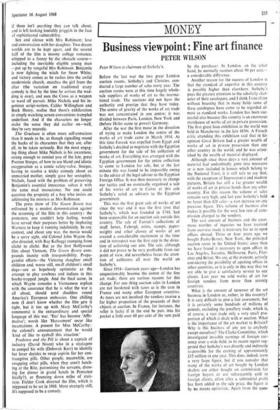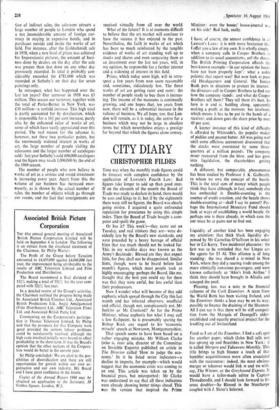Business viewpoint : Fine art finance MONEY
PETER WILSON
Peter Wilson is chairman of Sotheby's.
Before the last war the two great London auction rooms, Sotheby's and Christies, con- ducted a large number of sales every year. The auction rooms were at this time largely whole- sale suppliers of works of art to the interna- tional trade. The auctions did not have the authority and prestige that they have today. The centre of gravity of the works of art trade was not concentrated in one centre; it was divided between Paris, London, New York and (before Hitler came to power) Germany.
After the war the first move in the direction of trying to make London the centre of the works of art trade came in March 1954. At this time Farouk was expelled from Egypt and Sotheby's decided to negotiate with the Egyptian government for the sale of his collection of works of art. Everything was arranged with the Egyptian government for the entire collection to come to London for sale, but at the last minute this was found to be impossible owing to the advice of the legal adviser to the Egyptian Foreign Office. It was then necessary to change our tactics and we eventually organised a sale of his works of art in Cairo; at this sale Sotheby's acted as advisers to the Egyptian government.
This was the first great sale of works of art since the war and it was the first time that Sotheby's, which was founded in 1744, had been responsible for an auction sale outside this country. The sale of Farouk's collections of snuff boxes, Faberg6, coins, stamps, paper- weights and other classes of works of art created a considerable excitement at the time and in retrospect was the first step in the direc- tion of achieving our aim. The sale, although it did not prove to be very profitable from our point of view, did nevertheless focus the atten- tion of collectors all over the world on Sotheby's.
Since 1954—fourteen years ago—London has unquestionably become the centre of the fine art trade; there are various reasons for this change. For one thing auction sales in London are not burdened with taxes as is the case in France and many other European countries. As taxes are not involved the vendors receive a far higher proportion of the proceeds of their cbjects at auction. In France, for instance, the seller is lucky if in the end he puts into his pocket a little over 60 per cent of the sum paid by the purchaser. In London, on the other hand, he normally receives about 90 per cent- s considerable difference.
Another reason for the success of London is that the standard of expertise in this country is possibly higher than elsewhere. Sotheby's pays the greatest attention to the scholarly char- acter of their catalogues, and 1 think I can claim
without boasting that in many fields some of these catalogues have come to be regarded al- most as standard works. London has been suc- cessful also because this country is an enormous storehouse of works of art in private possession. The first great loan exhibition in the world was held in Manchester in the late 1850s. A French critic attending this exhibition said that in his opinion Great Britain had a greater wealth of works of art in private possession than any other country in the world, and he was aston- ished by the wealth of material displayed.
Although since those days a vast amount of material had undoubtedly gone into museums or is now included in houses which belong to the National Trust, it is still safe to say that, with the exception of Impressionist and modern pictures, Britain has still a far greater wealth of works of art in private hands than any other country. For this reason the volume of sales remains very high, and last year Sotheby's held no fewer than 428 sales—a vast increase on any previous figure. This volume of business also makes it possible for the very low rate of com- mission charged to the vendors.
The vast amount of business and the enor- mous number of inquiries we have received from overseas made it necessary for us to open offices abroad. Three or four years ago we bought Parke-Bernet, New York, the principal auction room in the United States; since then we have found it necessary to open offices in Los Angeles, Toronto, Melbourne, Paris, Flor- ence and Beirut. We are, at the moment, actively considering the possibility of opening offices in other countries, as it is only in this way that we are able to give a satisfactory service to our clients. Last year we sold works of art for foreign vendors from more than seventy countries.
What is the amount of turnover of the art business in London or, rather, in this country? It is very difficult to give a fair assessment, but it is certainly some hundreds of millions of pounds, excluding the jewellery trade, which is, of course, a vast trade only a very small pro- portion of which is dealt with at auction. What is the importance of the art market to Britain? Why is this business of any use to anybody except ourselves? The Clarke Committee, which investigated invisible earnings of foreign cur- rency over a wide field, in its recent report sug- gested that Sotheby's was directly and indirectly responsible for the earning of approximately i15 million in one year. This does, indeed, seem a very large figure, but if you consider that many of the works of art bought by London dealers are either bought on Commission for foreign buyers or are subsequently sold to foreign clients, often after a substantial profit has been added to the sale price, the figure is by no means optimistic. Apart from the ques.
tion of indirect sales, the saleroom attracts a large number of people to London who spend a not inconsiderable amount of foreign cur- rency in staying in expensive hotels, and in purchases outside and inside the works of art field. For instance, after the Goldschmidt sale in 1958, when a new level of prices was achieved for Impressionist pictures, the amount of busi- ness done by dealers on the day after the sale was greater than that done on any other day previously recorded. In total it probably con- siderably exceeded the £781,000 which was recorded at Sotheby's on that day for seven paintings only.
In retrospect, what has happened over the last ten years? Our turnover in 1958 was £3 million. This season our turnover, together with the total of Parke-Bernet in New York, was f30 million—a tenfold increase. This high total is partly accounted for by devaluation, which is responsible for a 16; per cent increase, partly also by the enhanced value of works of art, some of which have vastly appreciated over this period. The real reason for the advance is, however, not these two particular points, but the enormously widened interest in works of art, the large number of people visiting the salerooms and the larger number of catalogues sold : last year Sotheby's sold 600,000 catalogues and the figure may reach 1,000,000 by the end of the 1969 season.
The number of people who now believe in works of art as a serious and sound investment is increasing every year. Apart from this the volume of our business has increased enor- mously, as is shown by the actual number of sales, the number of objects which go through our rooms, and the fact that consignments are received virtually from all over the world.
What of the future? It is at moments difficult to believe that the art market will continue to have the success it has enjoyed in the past. Nevertheless, the faith in works of art which has been so much reinforced by the tangible evidence of works of art standing well up to stocks and shares and even surpassing them as an investment over the last ten years, will, in my opinion, be responsible for a further interest and a widening of interest in this field.
Prices, which today seem high, will in retro- spect a few years from now seem reasonable and, sometimes, ridiculously low. The finest works of art are getting rarer and rarer: the number of people ready to buy them is increas- ing. The income of the museums is continually growing, and one hopes that, ten years from now, there will be a substantial increase in the volume of business. We all hope, too, that Lon- don will remain, as it is today, the centre for a business which may not be large in absolute terms but which nevertheless enjoys a prestige far beyond that which the figures alone convey.



































 Previous page
Previous page